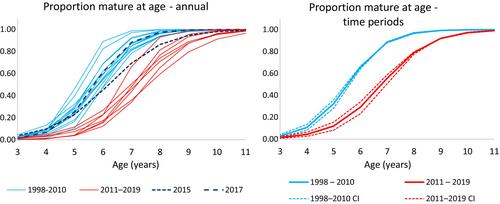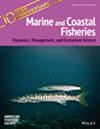Our aim was to predict the maturity (will spawn or immature) of Sablefish Anoplopoma fimbria in Alaska for past years during a period when macroscopic data are not of utility and histological observations are not available.
In a previous study, female maturity was determined using histology and a model was developed that predicted maturity using maternal length, age, and relative condition. We used this published model to predict the maturity of individual Sablefish collected annually in the same area on the same dates. The maturity predictions were used to create predicted time series of maturity at age for surveys conducted over 22 years.
A k-means cluster analysis of annual maturity parameters revealed that data should be split into two clusters. These groups were chronologically sequential (1998–2010 and 2011–2019), with two exceptions: 2015 and 2017 were assigned to the early time period. We created two chronological time blocks by incorporating the two outlier years into the late period post hoc, as we are not aware of mechanisms that may have caused these two outliers, and it is important for stock assessment to capture the signal and not the noise. Sablefish in the later period were predicted to mature later than fish in the earlier period; age at 50% maturity was 5.5 years in the early period and 6.8 years in the later period, and the slope was shallower in the later period.
There are often gaps in reliable maturity data. This case study illustrates that limited histological data sets can be used to predict maturity in years without ovary samples and illustrates how these data can be grouped based on similarities and chronology for use in stock assessment. We recommend more histological studies in the future to test assumptions of the predictive model, and we recommend evaluations of other factors, such as environmental time series, that may be drivers of annual maturity.



